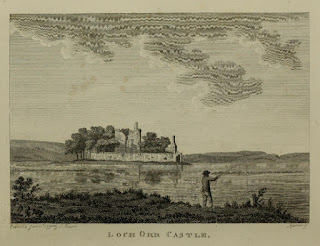After
taking a trip to the Wemyss Caves, I made my way around and up to the hill
above them. On top of this hill, there sits a ruinous and crumbling tower, this
is all that remains of Macduff’s Castle.
This Castle has traditionally been associated with the Eleventh Century
Thane of Fife, Macduff, and was the setting of a very famous fictional
murder. It was here that Shakespeare had the evil assassins, sent by
Macbeth, brutally murder Macduff’s wife and children. Of course, Shakespeare
made all of this up and none of it actually happened, and though it was
believed the Thane of Fife had a fortification somewhere around the area, it is
not known where.
The
earliest part of the castle that stands here now was built in the Fourteenth
Century by the Wemyss family, who were descendants of the Macduff’s. Later
buildings were added in the fifteenth and Sixteenth centuries and the castle
ended up consisting of two towers connected by a gatehouse sitting between them. As with many castles, Macduff’s castle was
owned over time by several families who added some buildings and modified
others. Then in 1630 it was bought back by the Wemyss family. The last records of it being in use was in
1666 when Lady Jean Wemyss, Countess of Sutherland, sent her children to live there
as she was worried that the plague ravaging parts of England would reach
Edinburgh. It didn’t. At some point after this the castle was
abandoned and fell into decay and ruin.
Up until 1967, two of the castle’s towers still stood, but then fearing
for the safety of children playing around the ruins, Fife Council had the
eastern tower demolished. Then, in the
1970s a Dovecote that had stood on the shore down from the castle was destroyed
by the sea. What remains of the castle is crumbling and cracked with much
hidden in deep undergrowth. It is
however now a Scheduled Ancient Monument.
Macduff’s
Castle, like all good castles, has tales of a ghost wandering its empty
ruins. Known locally as the Grey Lady,
she is said to be the ghost of Mary Sibbald. The story goes that she
was a servant girl at the castle who was accused of theft. At her
trial she vehemently denied the charges, but was found guilty and sentenced to
be publicly flogged. The executioner who carried out the flogging
was a cruel man, and so severely did he strike her that she died a few days
later of her injuries. Ever since, she has wandered the castle and
its grounds silently protesting her innocence to anyone who may see her.
* * *
Ignoring
the danger to life signs, I pushed myself through bushes and undergrowth and made
my way around the castle.
At
the back there was an entrance of crumbling stone into what I assume was a
cellar. Inside it was damp and dank with
a floor littered with cans, bottles and a condom or two. Lovely.
Leaving the cellar and cutting around, I made my way to the main part of
the remaining tower and clambered up onto the crumbling stage like floor.
The
place was a perfect setting for a performance of Macbeth, and I could almost
imagine the arrival of the assassins –
Lady Macduff:
(On being told by a messenger she should flee the castle)
What are these faces?
Where is your husband?
Lady Macduff:
Murderer:
He’s a traitor.
Macduff’s
Son:
Thou liest, thou shag-eared villain!
Murderer:
Macduff’s
Son:
(Exit Lady Macduff crying - Murder!)
* * *
Before
leaving the castle, I left the Skulferatu that had accompanied me in a hole in
the wall of the tower.
The
coordinates for the location of the Skulferatu are -
I
used the following sources for information on MacDuff’s Castle –


























































